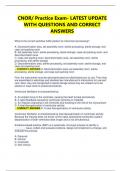CNOR/ Practice Exam- LATEST UPDATE
WITH QUESTIONS AND CORRECT
ANSWERS
What is the correct workflow traffic pattern for instrument processing?
A. Decontamination area, set assembly room, sterile processing, sterile storage, and
case cart packing room
B. Set assembly room, sterile processing, sterile storage, case cart packing room, and
decontamination area
C. Case cart packing room, decontamination area, set assembly room, sterile
processing, and sterile storage
D. Decontamination area, sterile processing, set assembly room, sterile storage, and
case cart packing room
- CORRECT ANSWER A. Decontamination area, set assembly room, sterile
processing, sterile storage, and case cart packing room
First, the instruments must be decontaminated and disinfected prior to use. Then they
are assembled in sets/trays and sterilized per manufacturer's instructions for use and
care. Next, they are transported to sterile storage where they are rotated out to be
placed on case carts for posted procedures.
Ventricular fibrillation is characterized by:
A. An ectopic focus in the ventricles, causing the heart to beat prematurely
B. A rapid heartbeat caused by ventricular ischemia or irritability
C. An impulse originating in the ventricles and traveling to the rest of the myocardium
D. A total disorganization of ventricular activity
- CORRECT ANSWER D. A total disorganization of ventricular activity
Ventricular fibrillation is characterized by total disorganization of ventricular activity.
Because the impulse does not travel via the rapid, specialized conduction system,
depolarization of both ventricles takes longer and is not simultaneous.
Evidence-based practice (EBP) is a systematic, thorough process to identify a
________ issue, collect and evaluate evidence, design and implement a change, and
evaluate the process.
A. Personal
B. Clinical
C. Corporate
D. Non-clinical
,- CORRECT ANSWER B. Clinical
EBP is a systematic, thorough process to identify a clinical issue, collect and evaluate
best evidence, design and implement a practice change, and evaluate the process. EBP
uses research to guide practice, utilizing scientific evidence rather than opinions to
implement practice changes.
When the patient's arms are extended on arm boards, the palms should be positioned
face up to decrease pressure on the:
A. Brachial plexus
B. Median nerve
C. Ulnar nerve
D. Radial nerve
- CORRECT ANSWER C. Ulnar nerve
Placing the patient's palms up decreases pressure on the ulnar nerve. Arm boards
should be at less than 90 degrees, padded, and with the patient's arms/wrists in neutral
alignment.
Aseptic technique is also known as:
A. Clean technique
B. Sterile technique
C. Sterilization
D. Decontamination
- CORRECT ANSWER A. Clean technique
Aseptic technique refers to clean methods of containing microbial contamination in the
environment. The environment cannot be sterilized.
An intrinsic factor that contributes to the development of a pressure injury is:
A. Pressure
B. Hypothermia
C. Diabetes mellitus
D. General anesthesia
- CORRECT ANSWER C. Diabetes mellitus
An intrinsic factor is related to the health of the patient. Diabetes mellitus is an intrinsic
factor that contributes to the development of a pressure injury.
Which of the following helps determine a patient's discharge destination?
A. Written discharge instructions from anesthesiology and medical staff
B. Risk of postoperative complications
C. Standardized pain scoring
, D. General condition and readiness for discharge
- CORRECT ANSWER B. Risk of postoperative complications
The choice of discharge site is based on patient acuity, access to follow-up care, and
the potential for postoperative complications.
Central nervous system (CNS) signs and symptoms of local anesthetic systemic toxicity
(LAST) include:
A. Hypertension
B. Numbness of lips and tongue
C. Respiratory depression
D. Elevated temperature
- CORRECT ANSWER B. Numbness of lips and tongue
CNS symptoms of LAST include circumorally and tongue numbness. All other options
are not considered part of the CNS.
Autologous bone grafts should be stored at a temperature of:
A. 68*F (20*C)
B. 32*F (0*C)
C. -4*F (-20*C)
D. -112*F (-80*C)
- CORRECT ANSWER C. -4*F (-20*C)
Maintaining storage temperatures within recommended parameters of -4*F (-20*C)
helps ensure that auto grafts are maintained in optimal conditions for successful
replantation.
When providing patient education for a child, it is important to understand which
learning characteristics of children?
A. Children are self-directed
B. Children use intrinsic thought processes
C. Children respond to use of activities that follow transitions of maturity.
D. Children respond to a trial-and-error approach
- CORRECT ANSWER D. Children respond to a trial-and-error approach
When teaching children, using a trial-and-error approach is effective. Child learners are
task-oriented, use extrinsic thought processes, and value self-esteem.
Which of the following actions would decrease radiation exposure during fluoroscopy
procedures?
A. Positioning the patient as close to the tube as possible




